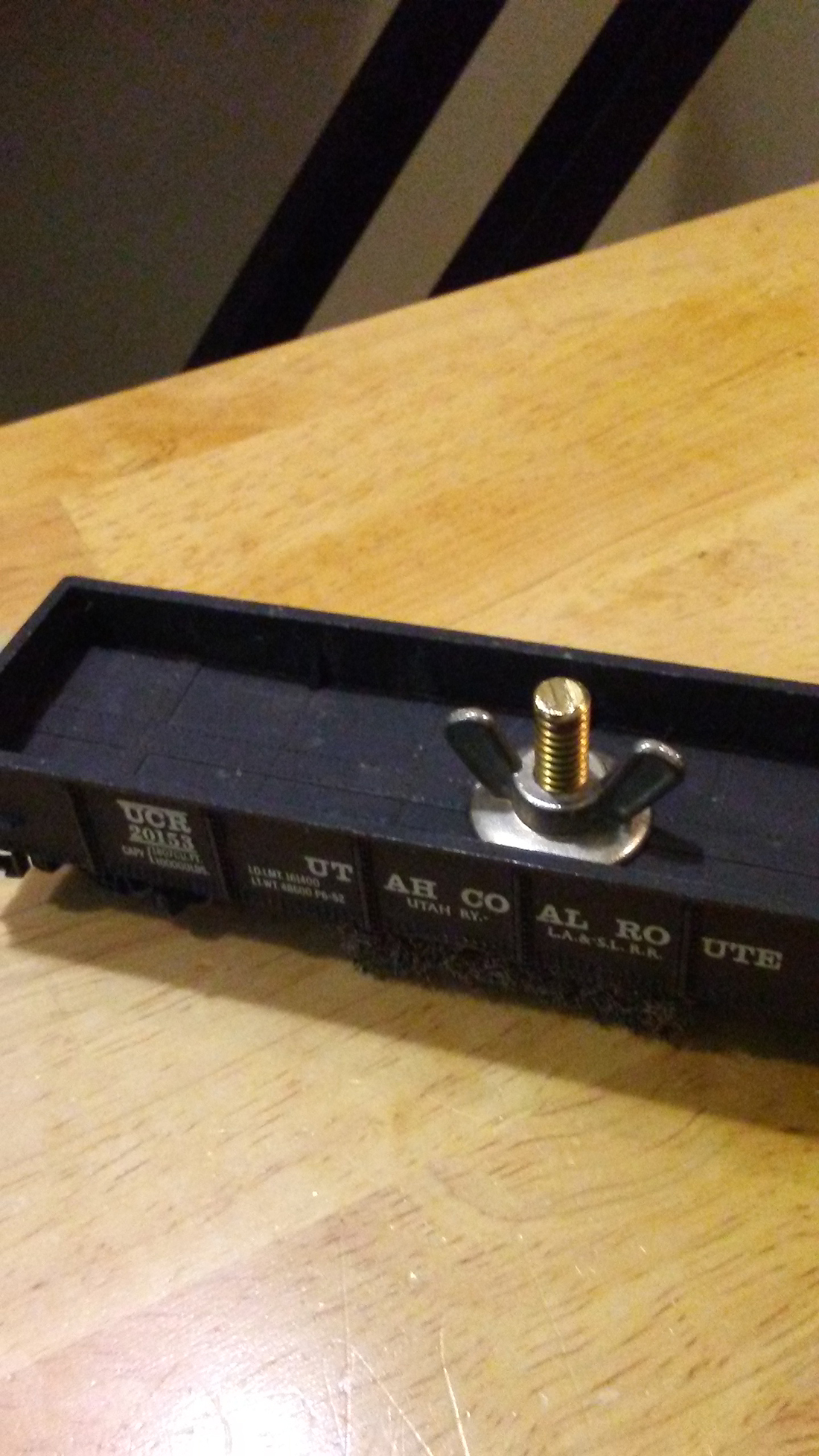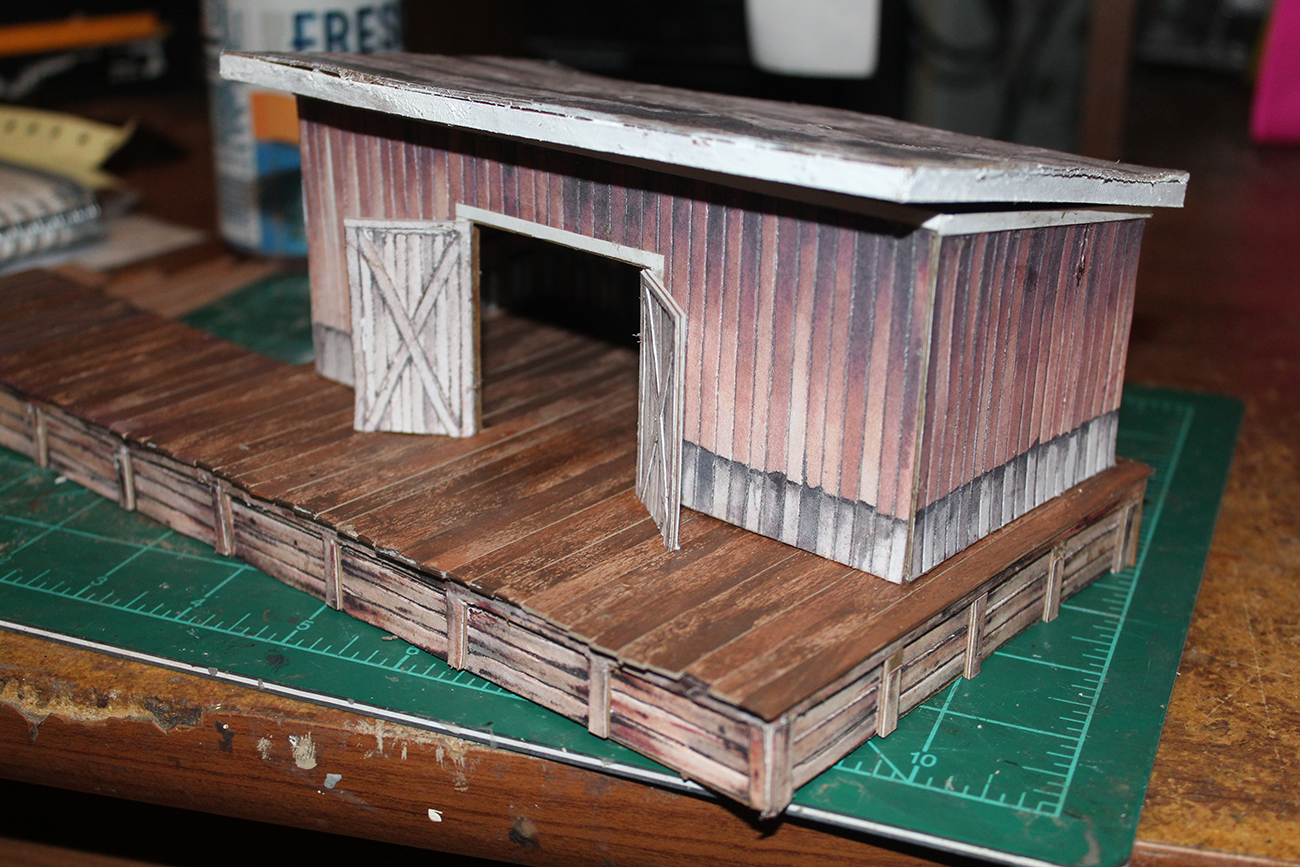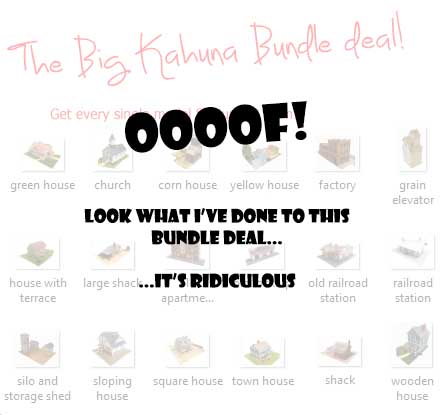Robert’s been in touch with his model railroad track cleaning tips:
“Hi Al
Robert here just made this track cleaner and works better then any store bought Simple to make track cleaning car.
Look for a gondola you won’t mind drilling a hole through the middle, drill through the weight. Get yourself a floor scrubbing pad and cut to size.
Your Home Depot / Lowes has 16” size or the paint isle has smaller hand held scrubbers.
You can buy a flat head bolt. Mine is from a toilet seat kit that i didn’t use.
For the cleaning liquid is your call. I use rubbing alcohol because it cleans and evaporates quickly. Buy any size cut to fit.
Enjoy Robert”
When it comes to model railroad track cleaning tips, there’s quite a few on the blog now.
These spring to mind:
Model railroad track cleaning car.
“As an “Old School Modeler” I learned from my Dad a long Time ago that if you don’t have “good track work” as in “Your Track/Layout and connections are PERFECT… It won’t be fun to run the trains!”
This is exactly what my dad instilled in me over forty two years ago when I was in my pre/early teens.
Back then we had switched from American Flyer ‘S’ gage to HO, because back then we didn’t have “E-Bay” or the internet or “after markets” and “Re-Pops”. Sooo getting parts and stuff for those old American Flyer trains was alot more difficult!
So when we switched to HO… first off we could build alot bigger layouts with the tables we already had… and do alot more detailing! And it was pretty affordable too.
And I’ve always loves seeing what I could do with Smaller Trains and slot cars too! 🙂 so this was a win-win for us!
but… it also meant taking much more time to get things right!
In Smaller Scale… things like tight curves, gaps etc. get alot worse and made for attention to what we were doing much more critical!
If your track work does not work flawlessly, no amount of electronics. scenery, realism, operations, etc. will ever make you want to head for the train room. Take your time on the track work, make if bullet proof, and everything else will be a delight!”
However It wasn’t easy for me (as a Kid!) because my Dad and I had spent a good chunk of money getting all New Stuff! And of course being a kid I couldn’t wait to run it all! (Hell I’m still that way now! LOL 😀 )
So “patience” and “time taking” was something I really had to learn! But it did all pay off! Once we got ALL of the “bugs” worked out on the main layout… which also taught us a lot in just how “tight” we could make turns and how steeo we could make grades and such… and when we later added on the back “Train Yards” on the other side of our wreck room wall (And into the laundry/utility room!) it went down without a hitch including the “Round House” and “Repair Yards”!
What also Helped was using what we dubbed “The “Bitch” because it was a Steam Locomotive that would de-rail from a shadow it was so Sensitive!
So once “The Bitch” ran the entire Layout five times without a hitch or stopping or de-railing, then we knew it was all ready to nail down permanently!
I will also add to this… If you don’t have enough ‘power’ for your layout… especially if it’s a gin one like we ended up with… that too will add to frustrations!
So Power the tracks / trains with multiple power sources, add “bypass” wires from the Power Sources to multiple areas of the tracks to ensure continues power flow so you won’t get “dead Spots” and Power the “extras” (i.e. Lights. Switches, Etc.) with seperate power sources!
This will make for a much nicer time running things and if you have a “Snafu” in anything… you only have to mess with that circuit setup and not the entire layout.
Joe
Jefferson Wisconsin”
“I have an HO two level, (not inter-connected), layout which fills a room of about 25 by 25 feet. I built it myself and made every mistake in the book and then some.
Some thoughts:
I find it a problem when the track is further away than my arm’s reach.
I find it a problem when there are no “emergency hand access” holes in totally covered mountain scenery.
I find it a problem where there are no “people access holes” on large table tops.
I find it a problem when a layout is densely complex with turn-outs, switch backs, short sidings, etc.
Another point:
It was a BIG Problem when I added a second main line next to and basically following the already installed, original main line:
Clearance problems, (particularly for tunnel entrances, and for long freight/passenger cars), radius problems, wiring problems, turn-out interferences, track side structures, etc. Disappointed
Another problem: if you are going to install a Round House and turntable, make sure you have sufficient, (yes, more than you think necessary), “lead in track” so that your longest locomotive can line up properly and enter the turntable and exit the turntable and smoothly enter the Round House.
Also watch out for track alignment and track elevation problems on the entrance and exit of the turntable.Weary
Another issue: I used flex track around the long curves. Watch out. Flex track is great. However when you bend it around to make a curve you are inducing “locked in stresses”, (yes I know, I am an engineer).
These “locked in stresses”, over time, may cause track misalignments and may even cause the track to warp in a vertical plane, popping off the road bed. If the involved section of track is beyond your arm’s reach, you may have an “Advil” headache problem.
Frank in San Diego”
“Hi Al…
just downloaded this video showing a problem I have, maybe someone can sort for me, also a tip on cleaning the tracks, and a bit of a running session.
Just sit back and enjoy…
Regards
Dave”
Latest ebay cheat sheet is here.
And finally for today, cast your mind back to the scratch building competition.
I said the winning building will be put on the site for a free download. Well, here it is:
Click here to download John’s winning freight shed.
And here’s a pic of it:
That’s all for today folks. Who can help Dave? Leave a comment below if you can.
Thanks to Robert for his model railroad track cleaning tips.
Please do keep ’em coming.
And if today is the day you get started on your layout, the Beginner’s Guide is here.
Best
Al
PS Latest ebay cheat sheet is here.
PPS More HO scale train layouts here if that’s your thing.
And there’s the Silly Discount bundle too.





Joe Good to see another modeler stressing the need for good track alignment / laying. Patience is indeed the secret and test test and test again.
Dangerous Dave. I wonder if the infa red unit is faulty. I see it does work using the switch option so the signal itself must be working fine. The electronics would appear to be working also as it uses the same switch to drop or raise the signal unit. It is a simple wiring diagram that you again appear to have wired correctly. This would lead me again to the actual infa red unit. Did it come pre-wired on to the circuit board ?. . Did you have to fit it to the board. Im not sure but could it be a bit like a transistor where it is crucial that the connections are correctly wired. I think If it came pre-wired I think I would send the unit back and ask the manufacturer to test it.
Well done John for winning the best scratch design.
Dave Your wagon track cleaner will clean the track but will not pick up the dust/dirk on the track. Your spirit cloth obviously does pick it up hence the large amount of dirt on the cloth.
I have been looking for elevated train platforms for H.O and I can not find any.Now a platform where the elevation is built into the platform instead of all that riser stuff all over the place.Can anyone advise on this matter?
Dave, you mention not seeing any lights on your sensor unit. Well you shouldn’t as you can’t see infrared.
You also don’t need to mount the sensor unit to test it. Just point it to a surface a few millimetres away and at right angles to it. A shiny surface would be best – the side of a wagon of loco would be ideal.
Hope this helps.
Best regards to you and all the other enthusiasts.
COLON; The scrubber takes up the grit/grease and the liquid rids the dust.Combined the two leaves a clean track!
The Critic
Just thinking a wee mod for the track cleaner could be to drill a tiny hole thru the wagon floor, and fill the wagon up with your-cleaning-fluid-of-choice so it steadily drips onto the cleaning pad to stop it drying out !?
Joe is absolutely correct on all points. Taking your time in the beginning is going to make your railroad enjoyable. I also use my steam engines to test my track work. They are so much more sensitive than a diesel unit. VERY important post !
Thanks Joe
For areas hard to reach on your layout(and assuming your hands and wrists work fine) I would reco buying one of those “reachers”.Older people use them to reach things like cans or jars in high places.Most have rubber on the grabbers,so if you are careful there won’t be any damage should a train de-rail.There are several different ones available,so shop until you find one that suits your needs,or buy 2 different ones. These are also excellent for holding vaccum hoses if you need to vac at places you cannot normally reach
Dave’s problem – I have no experience of these but the signal working on the push button will be independent of the sensor. If it were me I would go back to basics:
1. double check the sensor is correctly connected. (If it isn’t you may have blown it). It is very important to identify the terminal from the cutout corner of the sensor.
2. double check the signal leads are correctly connected.
3. The sensor requires a change in light. Remove it from the track and, with it all connected and ready to go, ENSURE NOTHING IS TOUCHING THE MODULE ELECTRONICS, pass something over the sensor lights (within inch) with the 2 lights at right angles to your movement. Should work. If it does your hole is not big enough.
I know you have the 8 page instruction sheet but there is a guide in colour at http://www.blocksignalling.co.uk/index.php/dapol-signal-module-dap1a if you haven’t looked at it. (i’m assuming it is the same module)
thanks for the video!!! enjoyed it all…esp the yard!! stay safe and well!!
The comment about being unable for the
naked eye to see infra-red light is
correct. However your cell phone camera
can. Choose the camera function, point
Phone and look at the cell phone screen.
I run three rail, I use Rubbing Alcohol Cleans the track great and it will dry up if you miss the wipe up on the rail. Simply use a soft rag with alcohol and wipe till clean, go back with clean dry rag till nothing shows up, I also use Goo Gone on switch’s does a great job but will leave a residue so wipe clean with dry rags. I also made a wood pole for the hard to reach places. Keeping rolling stock and engine wheels clean will help in keeping track clean.
If the sensor is supposed to emit infra-red, use your cell phone camera to see if it works. Your camera CAN see it.
Dave I read a troubling guide to infra red sensors that stated that overhead lights can affect the operation. At the moment I can’t recall which light bulb is best but I think LED bulbs work best for no interference with the sensor. I think florescent lights are the worst. Hope this helps. Always enjoy your videos. Also good advice on track cleaning. Thanks to Al for this site. I sure have gotten some sage advice here. Now if only I had more tome to work on my layout.
To Joe Jefferson and Frank in San Diego…….. Boy do I wish I had read something like this two and a half years ago before I started my layout. I was to anxious to get trains running and today I am still fixing and or replacing bad track installations. Most of my issues are not having a level base and turnouts.
You guys hit the nails right on the head……
Alastair….you should repost these blogs every 6 months so that new members and or beginners can start off on the right track.
Dave if you look under dapol signal wiring it will show a couple of ways to wire the signal
I’ve made a list of the many products model railroaders use to keep track clean:
NEVER USE sand paper or Bright Boys, both of which will scratch tracks and trap dirt
70 % alcohol, some say 90% but it will strip paint if you weathered your tracks)
Denatured alcohol (doesn’t leave residue)
Aero Fluid
Transmission fluid (place about one inch long w/Q tip — not too much!), and rr traffic will distribute the cleaner
No-Ox from Bar Mills (discontinued?)
RailZip
NeverStall
Hair clipper oil
Balsa wood and cleaner (balsa absorbs cleaner and doesn’t scratch)
Electrical contact cleaner (?)
LPS-1 greaseless lubricant (on Amazon)
CRC 2-26 (recommended for electrical contacts — at Home Depot)
ACT 606
INOX — from Australia
Enjoy
Hi Dave, I hope the missus is coming along well with her recovery.
I really enjoy your videos – Would you consider doing one focussing on scenery and buildings (stations, and yards, too), please? I find it really inspiring to see what you and others have done with the layouts and use (steal) many things you have included.
kind regards, Graeme from Bendigo Victoria, Australia
The only scratches you’ll see George is under a microscope and alcohol dissipates dirt and grit,you’ll mostly be cleaning dust particles anyway.And for some reason if you have to replace a section then go ahead ,That’s why they make more tracks.
The Critic